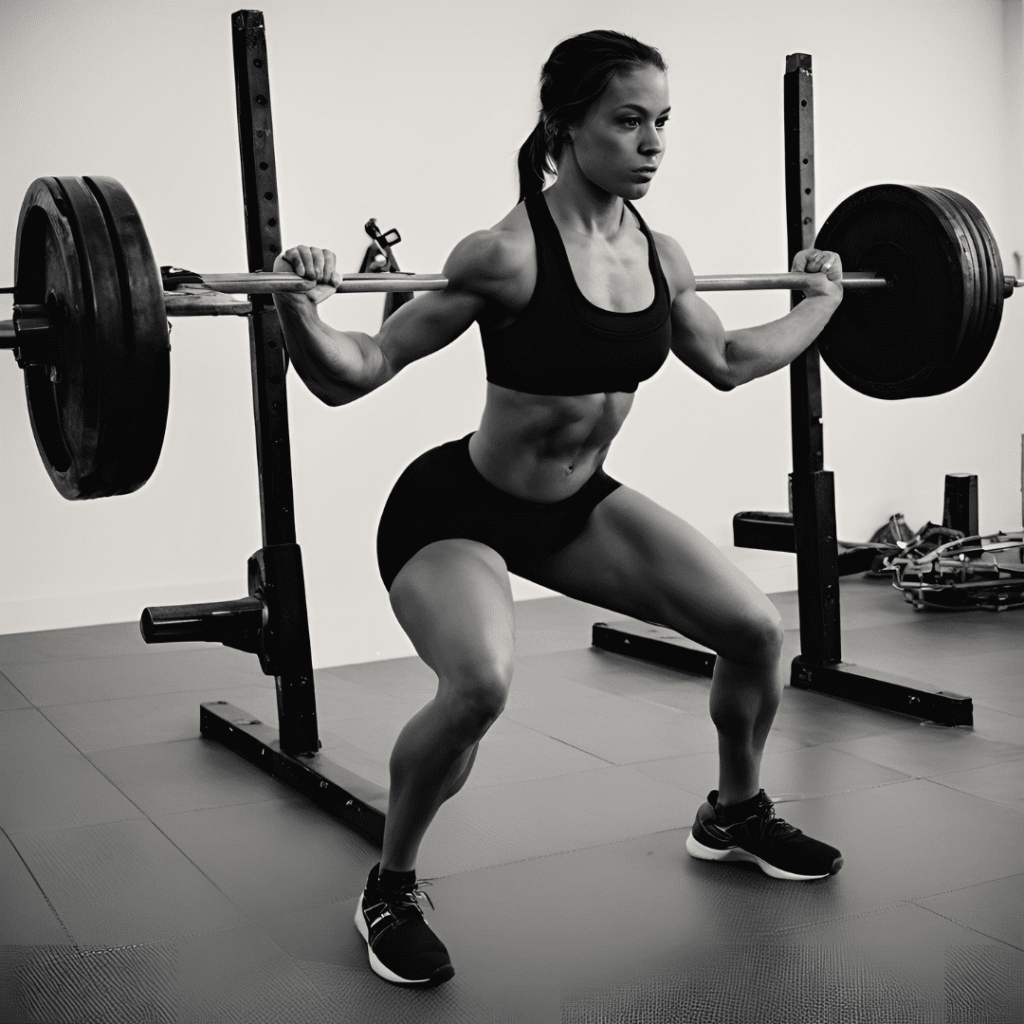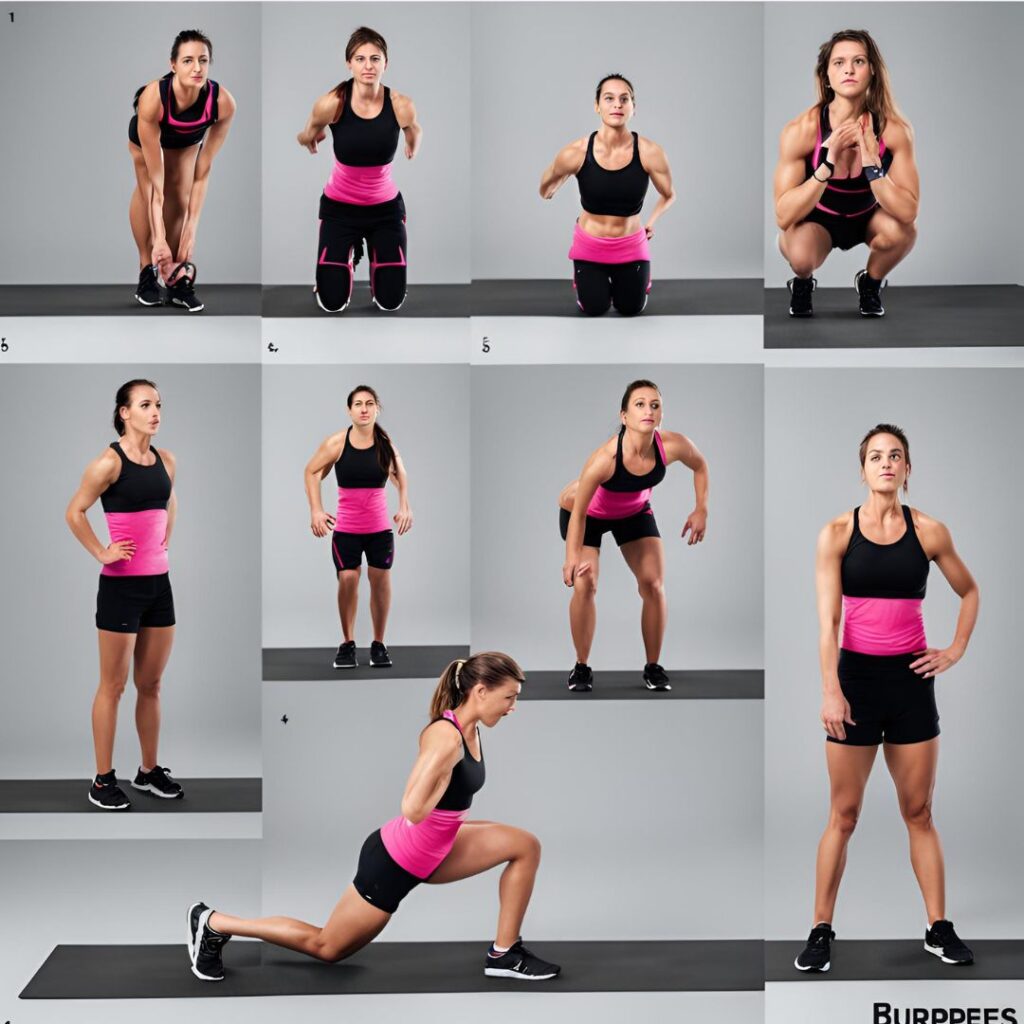
Staying fit and healthy doesn’t necessarily require a gym membership. You can achieve a full-body workout from the comfort of your home.
Here are the top seven exercises for full body workout that will help you stay in shape, targeting multiple muscle groups for a balanced and effective workout.
Table of Contents
Top 7 Exercises for Full Body Workout at Home
1. Push-Ups

How to Perform Push-Ups:
- Starting Position: Begin in a high plank position. Your hands should be placed slightly wider than shoulder-width apart, and your feet should be together or slightly apart depending on your comfort level.
- Body Alignment: Ensure your body forms a straight line from your head to your heels. Engage your core to maintain this alignment and avoid sagging or arching your back.
- Lowering Phase: Slowly lower your body towards the ground by bending your elbows. Keep your elbows at a 45-degree angle to your body. Lower yourself until your chest is just above the ground.
- Pushing Up: Push through your palms to raise your body back to the starting position, fully extending your arms. Keep your core engaged and your body in a straight line throughout the movement.
Benefits of Push-Ups:
- Builds Upper Body Strength: Targets the chest, shoulders, and triceps.
- Enhances Core Stability: Engages the core muscles, promoting better overall stability and balance.
- Versatile and Scalable: Can be modified for various fitness levels. Beginners can start with knee push-ups, while advanced practitioners can try variations like diamond push-ups or one-arm push-ups.
2. Squats

How to Perform Squats:
- Starting Position: Stand with your feet shoulder-width apart. Your toes should point slightly outward.
- Lowering Phase: Begin by pushing your hips back as if you’re going to sit in a chair. Bend your knees and lower your body, keeping your chest up and your back straight. Aim to lower your hips until your thighs are parallel to the ground, or as low as your flexibility allows.
- Knee Alignment: Ensure your knees stay in line with your toes and do not extend beyond them. Your weight should be distributed evenly on your heels and midfoot.
- Rising Up: Push through your heels to rise back to the starting position. Straighten your legs and squeeze your glutes at the top of the movement.
Benefits of Squats:
- Enhances Lower Body Strength: Targets the quadriceps, hamstrings, and glutes.
- Improves Balance and Mobility: Strengthens the muscles around the knees and hips, aiding in better balance and joint health.
- Functional Exercise: Mimics everyday movements like sitting and standing, improving overall functional fitness.
3. Planks

How to Perform Planks:
- Starting Position: Begin in a forearm plank position. Place your forearms on the ground with your elbows directly beneath your shoulders. Your body should form a straight line from your head to your heels.
- Body Alignment: Engage your core by pulling your belly button towards your spine. Keep your back flat and avoid letting your hips sag or rise too high.
- Head Position: Keep your head in a neutral position, looking down at the floor. Avoid straining your neck by keeping it aligned with your spine.
- Holding the Position: Maintain the plank position for as long as you can while maintaining proper form. Aim for 20-30 seconds if you’re a beginner, gradually increasing the duration as you build strength.
Benefits of Planks:
- Strengthens Core Muscles: Engages the rectus abdominis, transverse abdominis, and obliques.
- Improves Posture: Strengthens the muscles necessary for maintaining proper posture and spinal alignment.
- Increases Stability: Enhances overall body stability and balance, which can help in performing other exercises and daily activities more efficiently.
4. Burpees

How to Perform Burpees:
- Starting Position: Stand with your feet shoulder-width apart and your arms at your sides.
- Squat Down: Lower into a squat position with your hands on the floor in front of you.
- Kick Back: Kick your feet back to place yourself in a plank position, with your body in a straight line from head to heels.
- Push-Up (Optional): Perform a push-up by lowering your chest to the ground and then pushing back up to the plank position.
- Jump Forward: Jump your feet back towards your hands to return to the squat position.
- Jump Up: Explosively jump into the air, reaching your arms overhead.
- Repeat: Land softly and immediately go into the next repetition.
Benefits of Burpees:
- Full-Body Workout: Targets multiple muscle groups, including the chest, arms, thighs, glutes, and core.
- Burns Calories: High-intensity movement that significantly raises the heart rate, promoting fat loss.
- Improves Cardiovascular Fitness: Combines strength and cardio, enhancing overall fitness levels.
5. Lunges

How to Perform Lunges:
- Starting Position: Stand with your feet together and your hands on your hips or at your sides.
- Step Forward: Take a big step forward with your right leg.
- Lower Your Body: Lower your hips until both knees are bent at about a 90-degree angle. Ensure your right knee is directly above your ankle, and your left knee hovers just above the floor.
- Push Back: Push through your right heel to return to the starting position.
- Repeat on the Other Side: Repeat the movement with your left leg.
Benefits of Lunges:
- Builds Leg and Glute Strength: Targets the quadriceps, hamstrings, and glutes.
- Enhances Core Stability: Engages the core to maintain balance.
- Improves Balance and Coordination: Works the stabilizing muscles in the legs and core.
6. Mountain Climbers
How to Perform Mountain Climbers:
- Starting Position: Begin in a high plank position with your hands directly under your shoulders and your body in a straight line.
- Engage Your Core: Keep your core tight to maintain stability.
- Drive Knees Forward: Quickly drive your right knee towards your chest, then return it to the starting position.
- Switch Legs: Immediately drive your left knee towards your chest.
- Repeat Rapidly: Continue alternating legs as quickly as possible, mimicking a running motion.
Benefits of Mountain Climbers:
- Boosts Cardiovascular Endurance: High-intensity exercise that increases heart rate.
- Strengthens Core: Engages the abdominal muscles and lower back.
- Improves Agility and Coordination: Enhances coordination between the upper and lower body.
7. Bicycle Crunches

How to Perform Bicycle Crunches:
- Starting Position: Lie on your back with your hands behind your head and your legs raised, knees bent at a 90-degree angle.
- Engage Your Core: Lift your head, shoulders, and upper back off the ground, engaging your core muscles.
- Twist and Extend: Simultaneously twist your torso to bring your right elbow towards your left knee while straightening your right leg.
- Switch Sides: Twist your torso in the opposite direction, bringing your left elbow towards your right knee while straightening your left leg.
- Repeat: Continue alternating sides in a controlled manner, mimicking a pedaling motion.
Benefits of Bicycle Crunches:
- Strengthens Core Muscles: Engages the rectus abdominis and obliques.
- Targets Oblique Muscles: Effective for working the side abdominal muscles.
- Improves Coordination: Enhances coordination and balance between the upper and lower body.
Conclusion
Incorporating these top seven exercises into your home workout routine is a great way to achieve a comprehensive full-body workout. Push-ups, squats, planks, burpees, lunges, mountain climbers, and bicycle crunches are all highly effective exercises that target multiple muscle groups, improve cardiovascular fitness, and enhance overall strength and stability. These exercises require minimal to no equipment, making them perfect for home workouts.
By consistently performing these exercises with proper form, you’ll be able to build muscle, burn calories, and boost your endurance without the need for a gym membership.